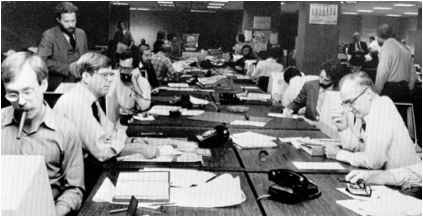|
As I sit here typing my little therapy blog – not in classic blogger underwear, I promise – I am supervised by a phalanx of editors.
They perch over my shoulder, the ghosts of deadlines past, monitoring my every whimsy. Before I can push the “Submit” button on my site, I must satisfy editors who kept me tethered for all those decades. They suggest temperate phrases like “alleged” and “so-called” and “was said to be” for assertions I cannot totally back up. “You need to do this over,” I can hear Jack Mann or Bob Waters snarling at me in Marine patois when I was learning to play the game right at Newsday. “Ummm, that doesn’t read like Vecsey,” I can still hear a Times national-desk editor named Tom Wark saying to me about a long profile of a bank robber who had earned a degree behind thick federal walls. “Could you run it through the typewriter again?” What a wonderful compliment. “Ummm, could you make a few more phone calls?” I can hear Metro copy-fixers like Marv Siegel and Dan Blum, or Bill Brink in Sports, saving me more than once. And early on Saturday mornings, right on deadline for my Sunday column, I would get a careful final read from the superb Patty LaDuca (about to retire, for goodness’ sakes.) When I am talking to journalism students, one of my main points is that if you have an editor supervising your work, you are actually participating in journalism. But if you expect your precious words to appear in print just the way you wrote them, you are merely a blogger. Editors keep you from making an ass of yourself. And sometimes the best editor is….yourself. I was thinking about editors a month or two ago when a major movie studio allowed “The Interview” to come out with the premise of the dictator of North Korea having his head blown off. Charming. The self-indulgent director waved the “creative freedom” flag, and the studio heads folded, with predictable world-wide tremors. Movie directors and producers could use a reality check from an editor – “Ummm, could you look that up?” -- when making films like “Selma” and “Lincoln,” as Maureen Dowd pointed out on Sunday. More recently, a weekly satire magazine in France published a cartoon of the Prophet Muhammad, touching off horrible violence around the world – violence that surely had been waiting to be fomented by opportunistic lunatics. Then the staff came back with another cartoon of the prophet. Was any of that necessary? Journalists have this implanted in their brains at an early age, by editors. What are the consequences? What does the other side say? Those of us who learned to present all sides – to make a few more phone calls – are lucky. So are the people who read (or watch, or listen to) those increasingly rare sources. (I don't count Stewart or Colbert. I am talking about their sources. That is, journalists.) * * * One of the most rational posts on the Charlie Hebdo issue is by Omid Safi, the director of Duke University's Islamic Studies Center, for that great site, onbeing.org. http://onbeing.org/blog/9-points-to-ponder-on-the-paris-shooting-and-charlie-hebdo/7193 And here are a few others: http://www.nytimes.com/2015/01/10/arts/an-attack-chills-satirists-and-prompts-debate.html?_r=0 http://www.newyorker.com/culture/cultural-comment/unmournable-bodies http://www.newyorker.com/news/news-desk/charlie-hebdo-shooting
Steve Zivin
1/20/2015 03:31:48 pm
Hi George,
George Vecsey
1/21/2015 01:20:39 am
Steve, thanks, you mean my World Cup book?
Altenir Silva
1/21/2015 09:18:37 am
Dear George,
George Vecsey
1/21/2015 10:13:03 am
Altenir, thanks, nothing wrong with being a blogger. One of the great developments of the new technology. A luddite like me can actually select photos....But the voice of an editor is what distinguishes.
Altenir Silva
1/21/2015 11:32:04 am
Dear George,
Altenir Silva
1/22/2015 08:47:53 am
Dear George,
George Vecsey
1/22/2015 10:55:49 am
Altenir, thank you. It's true. Having a powerful presence like Bradlee running the show gives a reporter confidence, but also the caution of knowing somebody is watching and will not allow rash words or ideas.
Altenir Silva
1/22/2015 11:09:50 am
Dear George,
John McDermott
1/22/2015 11:01:58 am
What you said about the value of having good editors applies equally to photographers. I am a measurably better photographer-and journalist-for having had great photo editors like Jim Kenney, John Whelan, Dave Wyland, Karen Mullarkey and others at Newsweek, Ted Theisen and John Dominis at SI, John Durniak and Arnold Drapkin at Time and others I could name.
George Vecsey
1/23/2015 01:08:46 am
John, great to hear from you. Totally agree with you about France. Paris and Lyon and Marseilles have been layered as long as I've been going there. We have been saved from starvation driving through the countryside on a Sunday evening when a Vietnamese family kept their pho shop open -- and the many ethnic layers all around. That 1998 French team (despite what the LePens said) was a monument to an evolving country -- I delineate all the ethnic roots in my soccer book. France has to do a better job. So does Germany. Then again, so does the USA. As a friend of ours, who worked in Brussels and Rome, said the other night, if young men could afford a wife or a girl friend, they'd be a lot happier. She is right.
John McDermott
1/23/2015 05:21:34 am
So true George. Just a little bit of personal success and recognition goes a long way. If Leo Burt had been four inches taller he'd have become an Olympic rower instead of a lifelong fugitive and one of the FBI's ten most wanted...(google Leo Burt, a guy from my hometown and a college classmate at Wisconsin).
omid safi
2/7/2015 01:00:13 pm
dear George, thank you so much for the kind words regarding my blog post which appears at OnBeing. You and I have a dear friend in common: your brother Chris, who was a much beloved colleague of mine for the years that I had the privilege of teaching at Colgate. Small world, indeed! Comments are closed.
|
Categories
All
|










